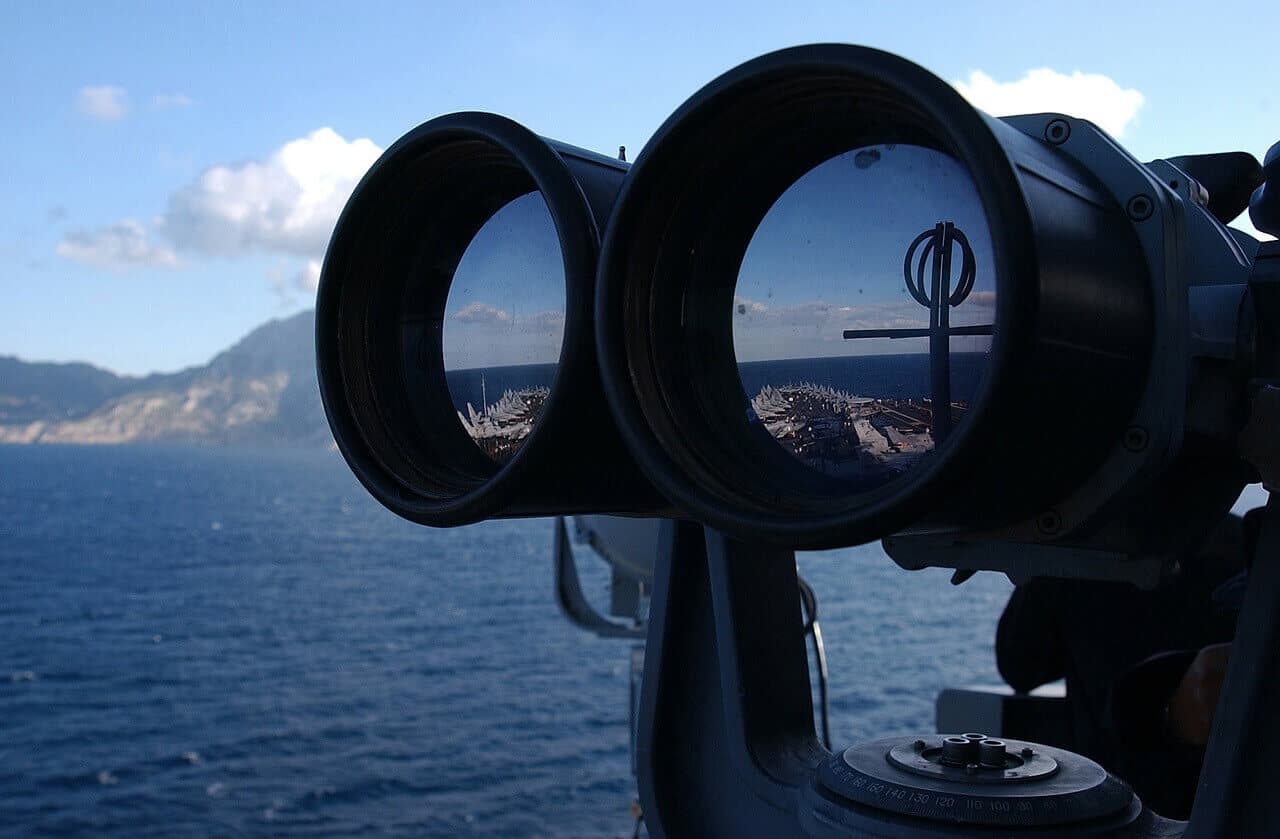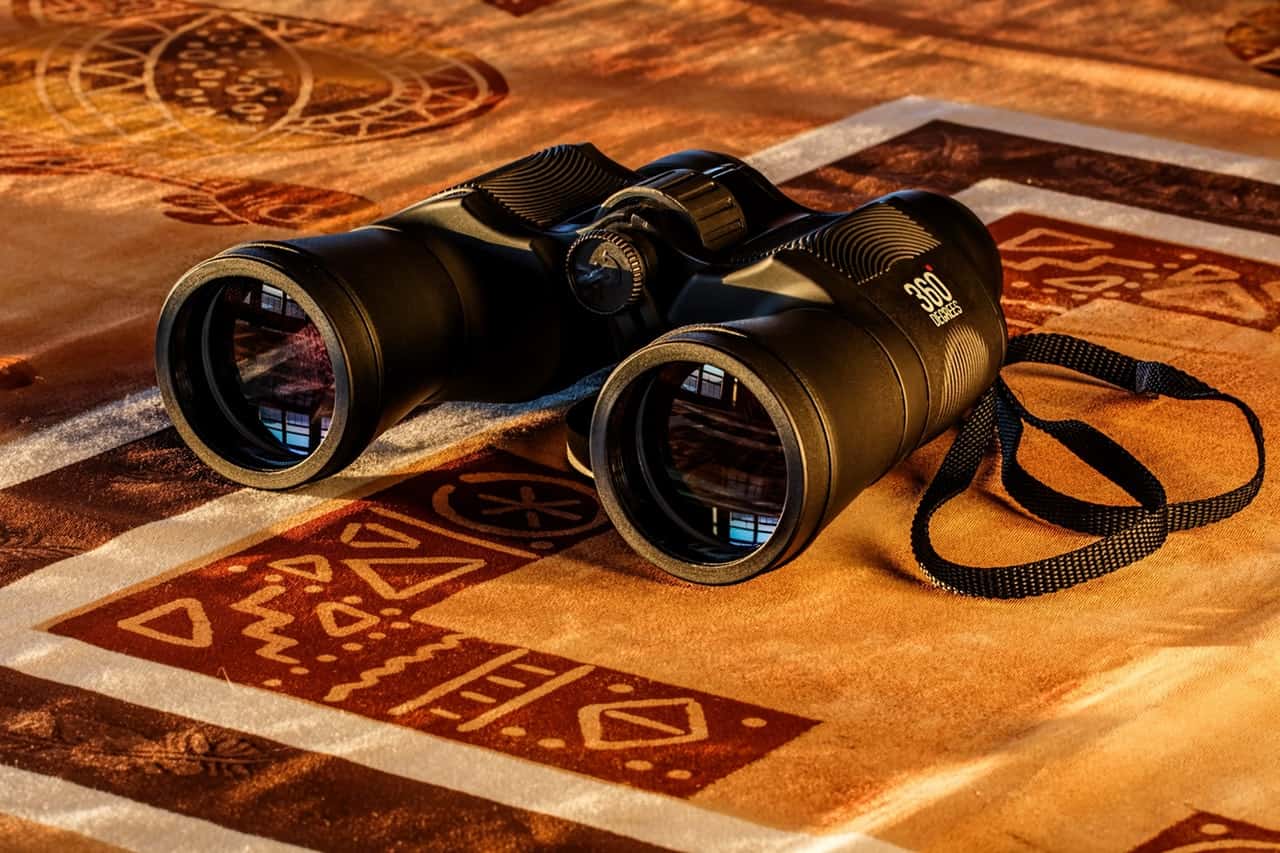Binoculars are your best friend if you love birding, hunting, sailing, or sky watching. But this best friend has one limitation; it feels the slightest movements and produces shaky views that can ruin the thrill of watching scenic views up-close.
When you wish to see galaxies or the bright colors of flying birds, the binoculars must be steady and shake-free; without this feature, you’ll struggle a lot. That’s when the image stabilization technique comes to the picture and makes your glassing activities more convenient.
Although image stabilization in cameras has been around for quite some time, there weren’t many IS binoculars till a few years back. Luckily, companies like Canon, Fujinon, and Zeiss have now launched a wide variety of image-stabilized binoculars that outpace bulky optics without compromising the performance.
If you’re new to the term IS binoculars, this detailed guide will answer most of your questions to help you make an informed decision. Read the following sections to know what image stabilization is, how it works, and why you should prefer it.
What are image stabilized binoculars?
When a binocular has a built-in gyroscope to sense motion and reduce its impact, it’s called an image stabilized binocular. Since hand-held binoculars feel the slightest movement in your body, you see shaky and hard-to-distinguish images. However, IS binos either have a gyroscope or electronic sensors that don’t let motion impact the views.
If you have ever used a tripod for horizontal glassing, you’d know the comfort of enjoying the view without holding the binos in place. But, that’s not suitable for celestial viewing or other important glassing sessions as a tripod limits your binocular’s movement.
On the other hand, an IS binocular lets you move in all directions without facing much vibration or jitters.
How do these binoculars work?
The significant difference between regular binoculars and IS ones is motion retention. An average binocular will feel the motion and impact the image accordingly, while a stabilized one will control that motion.
Image stabilized binoculars have motion sensors that manipulate the lenses’ movement, eventually increasing the image quality. Let’s assume you want to magnify a star while your binocular is pointed towards the sky. You’ll face continuous jitters at higher magnification levels because that’s when the lenses are working at their maximum capacity.
Image stabilization controls this movement without impacting the image quality so that you hold the binoculars comfortably.
Image stabilization can be divided into two categories, passive and active.
- Active stabilization
This technique uses electrical sensors that detect the degree of movement and adjust the binoculars accordingly. Let’s say your hand-held binocular is continuously moving as you try to focus it somewhere. The sensors of an actively stabilized binocular will either shift the lenses’ position or the prism to compensate for this movement, improving the optical clarity.
These sensors are best for swift motions when you don’t have time to adapt to the changes and need on-point focusing.
- Passive stabilization
Binoculars with passive stabilization have a built-in gyroscope that detects movement and stops it from disturbing the imagery. This technique doesn’t use any sensors and relies solely on the prism or gyroscope.
Since movement affects the lenses, some passive systems have disengaged prisms as a coping mechanism. When your hand-held binocular shakes, its internals don’t move because they’re already separated from the housing. Although this stabilization is suitable for lower-end binoculars, it doesn’t work at higher magnifications.
Main parts of an Image stabilized binocular
Image stabilization is a step-by-step process that’s carried out with the help of multiple parts. Let’s discuss them first:
- Gyroscope
A gyroscope is a device used for sensing motion and preparing a binocular for the aftermath. When a bino receives shakes, its smart gyroscope manipulates the lenses and retains the motion.
- Sensors
The recent versions of image stabilized binoculars have electronic sensors that detect jerks and convey this message to the prism ahead of them.
- Corrected prism
Most image stabilized binoculars have Porro prisms that transfer a light beam in the form of a wave, eventually minimizing the shakiness to some extent. But, if we talk about higher-end image stabilized binoculars, there we have specially designed corrective prisms.
A stabilizing prism has two flat glass pieces with a central joint. This joint is called bellow with a high-density refractive fluid. This fluid is a silicone oil that removes jerks from a view and transfers a rectified image to the lenses.
After receiving signals from the gyroscope or electrical sensors, the prism manipulates the lenses to adjust with an approaching view, eventually improving the imagery.
What makes the image stabilized binos different?
These binoculars are designed to increase image retention and tilt in the views that you observe. When there is vibration, swell, or movement, a stabilized binocular doesn’t react the way a regular one would, which gives the lenses more time to adapt.
Since the views change slowly as you work with an IS binocular, you don’t feel little movement. And when there is a bigger shake, these binos quickly compensate for them.
Image stabilized binoculars pros and cons
Before heading to the activities where image stabilization comes handy, let’s check its pros and cons for a better understanding.
Pros
- Accessible
Stargazers often setup heavy telescopes or parallelogram mounts to make their hobby more feasible. However, moving around with a hefty set up isn’t practical, and you might be forced to leave it home while moving around. This is a big turn off for passionate glassers who need their favorite optic handy wherever they go.
Image stabilized binoculars easily replace their bigger counterparts and work as a convenient option, eventually making travelling more fun for you.
- Spontaneous
When you spot a worth watching object, these spontaneous binoculars ensure you don’t miss it. Since focusing with an IS bino is effortless, you’re always ready to clarify a view.
- Convenient
Big optic tools like tripods and telescopes are hard to pack. But, when you invest in a smart gadget that doesn’t lack any quality and is always handy, it doubles the fun of your activities. IS binoculars offer impressive optical performance without adding much weight to your gear.
- Fully balanced views
If you are a sailor, you’d know the struggle of maintaining a stabilized view. The continuous movement doesn’t let you enjoy a sight and adds extra pressure on your vision.
Image Stabilized binoculars remove that pressure and offer ease-of-focusing. You won’t have to repetitively adjust the magnification or aim point while working with these binoculars as they’re already well-balanced.
- Best for high magnification viewing
This is the main advantage of image stabilization technique. If you opt for a higher magnification i.e., 7x and above, the binocular shows vibration, mirage, movement etc. in the final view. This limitation doesn’t let you enjoy a view and asks for adjustment time and again.
With image stabilized binos, you don’t feel minor movement, shakes, and mirage, which again improves the image quality that you see.
- Suitable for on-the-go glassers
If you keep switching hobbies and need an optic that supports each one of them, get image stabilized binoculars for sure. From wildlife safaris to boating and from hunting to celestial viewing, these smart binos nail every task.
Cons
Now, let’s talk about the cons:
- Slow focusing
When somebody switches his aim point quite often, an image stabilized binoculars takes some time to adjust. Since there is a whole process going on to reduce shakes from a view, you must expect it’ll take a few extra seconds before you see results.
Even though this is not a limitation, it’s not something every glasser loves, and you should consider your planned activity before switching to image stabilization.
Speaking of activities, it’s about time we discuss the main fields where image stabilization works like a charm. Let’s move right in:
Image stabilized binoculars for birding
Bird watching is one of those hobbies that require focus, patience, and stability. When your binocular detects the slightest movement, you cannot identify the bird you’re looking at or might miss its important details.
Image stabilization impressively helps occasional and frequent birders who cannot hassle with wobbly or blurry views. No matter if you’re focusing a distant bird or a nearby one because image stabilization ensures you don’t see broken pixels or hard-to-decipher objects.
Always get a bino that guarantees true-colored views and no edge finding, because these specs make birdwatching a comforting activity.
What must a birding binocular have?
- Color fidelity
Bird watching isn’t limited to chasing and pinpointing flying birds; it’s more about studying their patterns and colors. If your binocular offers good stability but lacks color differentiation, it’s not suitable for birdwatching.
A birder expects to see all shades, features, and colors of a flying beauty, irrespective of its distance; hence, pick one carefully. Check for the lens coatings and glass quality to decide the type of views you’ll see in the future.
- Magnifying power
You cannot go near a bird without startling it. When you focus on a bird, make sure you’re distant and steady because that’ll let you learn more about it. Therefore, an image stabilized binocular for birding must come with incredible magnifying power that overcomes this limiting factor.
Being able to see unobstructed views at above 10x magnification is the main advantage of image stabilized binoculars as the imagery won’t make you dizzy at higher power.
- Stable views
This goes for every hobby, every binocular. When you receive shaky and incoherent views, it doesn’t make your adventures fun; instead, this becomes a liability in the long run.
While selecting an image stabilized binocular for birdwatching, check its weight, optical quality, and power to avoid any hassle in the future. If you chase wild birds, be ready for the struggle of steady views, because you never know the terrain you’ll end up on.
Also Read: Can I use my iPhone as a pair of binoculars?
My recommendation:
Canon 18×50 image stabilization all-weather binocular is the perfect choice for passionate birders who need everything 10 on 10. This binocular offers impressive color differentiation, which is crucial for birding.
Image stabilized binoculars for boating
Engine vibration, waves, and hand movement; when we talk about boating, many problems arise, collectively impacting your views. No matter if you’re a recreational sailor or it’s your job to track the moving boats, having image stabilized binoculars will be a huge help for your eyes.
Since most glassers stand on the deck of a boat, it’s hard for them to stay steady and focus their Aimpoint without getting tired. Image stabilized binoculars ensure your body/hand movement doesn’t disturb the view, and you stand comfortably.
Glassers often feel dizzy while viewing through a binocular as their eyes try hard to adapt to the motion. But when you get a smart device, this dizziness significantly reduces.
What must a boating binocular have?
- Handy design
Getting on a boat with heavy binoculars is always a no-no; you never know how grumpy the water gets as you proceed. Always opt for a lightweight image stabilized binocular that doesn’t compromise the optical performance either. When you can easily hold/hang a binocular while sailing, it lets you enjoy those challenging missions like a pro.
- Solid grip
The grip is the most crucial factor for a boating binocular; no one would want to damage it, right? When you buy an image stabilized binocular for boating, always check its housing. If it’s made from rubber or textured metal, you’re good to go. But if you end up with a sloppy IS binocular, boating will get even more difficult.
Soft neck-straps, foldable lens caps, and a carry case should also be in your checklist because no one can afford to damage their favorite glass on a voyage.
- Glare-free glass
When sunlight hits the water surface, it reflects and makes a view appear brighter than it should be. This issue is more problematic for binocular users, as they already view through glass lenses, and then there is mirage or glare to block a view.
Glare-free lenses and phase-corrected prisms solve this problem by making the views appear in their natural colors. When you check out a bino for boating, read about its lenses and see if they block glare or not.
If you wear glasses, it’s even more challenging to avoid glare and stay comfortable. That’s why never settle for a mediocre eye relief in your bino; get one that supports your glasses without tiring your eyes.
My recommendation
Fujinon Techno Stabi 14×40 is the best image stabilized binocular for sailors because it ticks all merit boxes. From glare-free lenses to excellent grip, you’ll find everything in it.
Image stabilized binoculars for astronomy
Astronomy is no easy play; you have to have the best gadgets to enjoy it. When you opt for a mediocre binocular, it kills half the fun of this adventure by showing you blurry views.
Whether you gaze at stars from your balcony or go out to enjoy this activity, a handy image stabilized binocular always makes it more interesting.
Most glassers have this misconception that telescopes are a must for astronomy, which is not valid any longer. Image stabilized binoculars have largely replaced telescopes, as they are more convenient.
If you love gazing at galaxies and those extra-bright stars, always keep an image stabilized binocular handy. Since these binos are lightweight, you don’t need a tripod or a parallelogram to keep them shake-free; sit comfortably on your balcony and enjoy excellent celestial views.
What must an astronomy binocular have?
- Angular movement
When you focus on a celestial body, your binocular must move in every direction to show you the best view. When you freely move your hand-held image stabilized binocular in all angles, it keeps you comfortable and well-informed simultaneously.
When your bino doesn’t compromise image clarity, it makes astronomy a truly relaxing hobby for everyone. These binoculars must control the tilt, which often disrupts the charm of celestial views.
- Ease-of-handling
No one likes tilting their head backward while holding a binocular. You must check your preferred astronomy binocular’s size and shape to avoid any trouble at the later stages, as not all of them come with ergonomic designs.
Always prefer light, well-balanced, and textured astronomy binoculars that don’t ask for a tripod. If your astronomy binocular is heavy, you’ll be forced to get a tripod, which is not very convenient.
- Incredible optical clarity
An average binocular doesn’t meet the standards of celestial viewing; it must be best at optical performance, magnification capacity, and lens quality.
When you easily zoom in on a celestial body without leaving your spot, it lets you enjoy the true essence of astronomy. Therefore, check for a binocular’s power before selecting it for any hobby.
My recommendation
Zeiss Carl Optical 20×60 is a beast when it comes to astronomy. This premium quality binocular has high-end lens coatings, an incredible built-in gyroscope, and a rugged body to support your missions. Since this one costs a lot, make sure your future plans are worth this investment.
How can you enjoy image stabilization with a traditional binocular?
Image stabilization is all about shake-free views, improved optical performance, and high magnification power. If your binocular has above 10x magnification, you can fairly stabilize its views with a few simple tricks. Let’s talk about them:
- Tripod
This is probably the easiest way to control jitters and enjoy a comfortable glassing session. When you’re tired, shift your binoculars to a steady tripod, and it will immediately control the shakiness which you might face otherwise.
When we stand in the same position for extended periods, it’s difficult to avoid body movement. Therefore, you should prefer a tripod-mounted binocular instead of a hand-held one.
- Added weights
When tripods don’t work in a windy or uneven region, add some weights for this job. You can either tie a few weights with your tripod or opt for one that has a heavy body. Robust tripods don’t let movement affect a view, but since they are heavy, carrying them around isn’t easy.
- Binocular frame
This one is difficult, but many binocular lovers find it to be very helpful. When you use a regular binocular for astronomy or just vertical focusing, mount it somewhere instead of holding it. A cross-body wooden frame like this one works the best for stabilizing views and keeping your hands free.
Final words
Image stabilization is best for extended glassing activities where you cannot hold a binocular without getting tired. Whether you’re on a moving object, i.e., boat, bus, safari keep etc. or need to exhaustively magnify a view, image-stabilized binoculars are your best bet.
These binos offer excellent magnification, color fidelity, stability, and ease of use, regardless of your task. If you’re tired of those jitters you feel while sailing or the super-blurry distant targets, get an image stabilized bino to overcome that issue.
I am sure my guide would have answered many of your questions related to this technology, and you’ll make a smart decision while getting a pair of IS binoculars.

Binos enthusiast since I was 12 – A real expert in all things optics including rifle scopes and red dots. Live in Dubai & love writing, beaches and eating!






